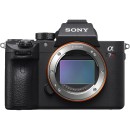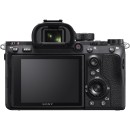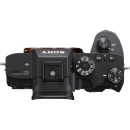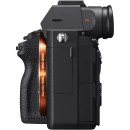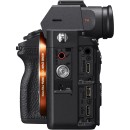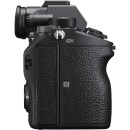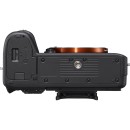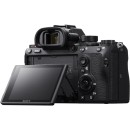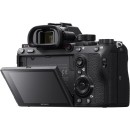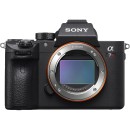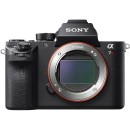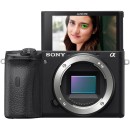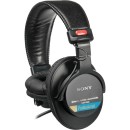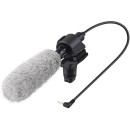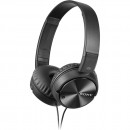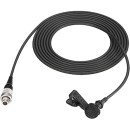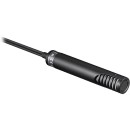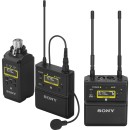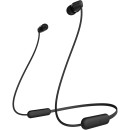- 42MP Full-Frame Exmor R BSI CMOS Sensor
- 5-Axis SteadyShot INSIDE Stabilization
- 3.69m-Dot Tru-Finder OLED EVF
- Built-In Wi-Fi/Bluetooth, Dual SD Slots
- 399-Point AF System & 10 fps Shooting
- ISO 102400 & Pixel Shift Multi Shooting
- USB 3.1 Gen 1 Type-C Port & PC Sync Port
- BIONZ X Image Processor & Front-End LSI
- 3.0" 1.44m-Dot Tilting Touchscreen LCD
- UHD 4K30p Video with HLG & S-Log3 Gammas
Introduction
In this article, we delve into a detailed analysis of 16,721 user reviews from various languages worldwide to examine the Sony Alpha a7R III. This analysis is performed by the RR artificial intelligence and updated daily with newly submitted reviews. The RR AI utilizes a complex algorithm to first scrutinize user reviews for credibility, filtering out unreliable ones. It then proceeds to dissect and evaluate the valuable insights within these reviews, providing users with ratings regarding the features of this product. Based on these assessments, users can make informed decisions about whether this product is suitable for them or not.
Ratings Based on Features
These results are a summary of user reviews of the Sony Alpha a7R III. For example, 78% of 541 users who have commented on the Touch Screen of the Sony Alpha a7R III have given positive feedback.
Highlighted Customer Reviews
Showing 1 to 20 of 343 Reviews
A7R iii Just stunning!

Sony Alpha a7R III Mirrorless Digital Camera Body with Accessories Kit
Reviewed by Hafeez on B&H Photo Video
After shooting Canon DSLRs for over 15 years and investing a lot in Canon lenses, I decided to try the A7R iii after reading reviews that said it now had one of the best focus systems available and Sony was making very good lenses. I was hoping to get a smaller camera than my Canon and the Sony body is a little smaller than my 5d III Canon but some of the Sony zoom lenses are actually big . The combination of fast 10fps with a 42MP is jaw dropping. Eye AF is now on whole new level and not only with Sony lenses but with Canon lenses also. The battery is larger and has a much greater capacity, so much less risk of running out of juice while touring and taking lots of photos. Still a good idea to get a spare battery. Simply Best Camera Ive ever owned! ... More
Absolutely Amazing

Sony Alpha a7R III Mirrorless Digital Camera Body with Accessories Kit
Reviewed by Benjamin on B&H Photo Video
I come from a DSLR background, having used Canon for over 15 years. After much hesitation I switched over completely to Sony, trading in all my Canon gear and getting two A7R IIIs and six lenses. To my surprise, I'm not missing Canon at all, and now that I've used the Sony system for several months, it's hard to imagine going back. There are so many features that have become integrated into my working style. First off, the positives. Excellent 4K video, in easy-to-work-with MP4 files. Yes, the codec is pretty compressed compared to higher-end video cameras (and lacks some great features of the GH5, like 10-bit color), but as long as your white balance and exposure are good, the files are a pleasure to work with. Ability to switch between full-frame and Super 35 is terrific, for both video and, surprisingly, for photography as well. When doing photography, if you're OK with the smaller Super 35 file size (and it's still relatively big), then every lens you use becomes a whole set of other lenses, i.e. a 16mm lens becomes 24mm when shooting in Super 35. The EVF is superb, and has many advantages over an OVF: you can see your exposure while shooting, do focus peaking when manually focusing, and can shoot into the sun without blinding yourself. The articulating LCD is very good, and makes getting lower and higher angles much easier. I also often use it when doing 'normal' angles, because it's simply rather nice to look down into an LCD sometimes, similar to the old days when I looked down into the viewfinder of my Hasselblad 500. The sensor quality is unbelievable: as much detail as you could ever want, with loads of dynamic range. As for color, people have criticized Sony's color science, but I actually love it. It's very neutral and natural, in a good way. I much prefer it, for instance, to the overly pinkish and processed-looking colors from a Fuji camera. The camera feels wonderful in the hand; without a battery grip it's too small, with nowhere for your pinky finger to go, but with a battery grip or grip extension, it's 'just right.' Much nicer to carry around, I think, than a DSLR, which feels like a bowling ball in comparison. One of the best features is the IBIS, which has transformed how I work, especially when doing video. I can't imagine living without this now. I can do video interviews lasting several minutes, all handheld, if I need to; something that would have been unthinkable with a DSLR. The autofocus is excellent, and the eye-AF, although not infallible (the way some reviewers have suggested) is a great technology. Continuous autofocus in video is also very good, almost on the level of Canon's DPAF. Customizable buttons are another super feature: between these and the 'My Menu,' it's actually quite easy to program and find the features you use most. Although Sony's menu design isn't going to win any awards, I think it's not nearly as confusing as some people make out. Last but not least, the lenses. Sony has done a class-act job of creating lenses that aren't just 'good enough,' but could even be considered some of the finest glass in the world. For example, the Sony/Zeiss 50mm f1.4 or GM 85mm f1.4, both of which are optically perfect, as far as I'm concerned, and have wonderful 'character.' All the GM and Sony/Zeiss lenses I've used so far are at least the equal of the Canon lenses I've used for so long. Is there anything negative to say? Hardly any reviewers of this camera mention dust, but in my experience, dust gets onto the sensor really easily, and you have to constantly have a blower on hand to get rid of it. During my DSLR years, I rarely gave dust a thought, but now I have to be vigilant with it. The LCD is good, but doesn't quite compare to the Canon 5d Mark IV LCD. Images don't look as crisp, the LCD itself is smaller than that of the Canon, and it lacks the full touch sensitivity of the Canon. However, it's still an excellent LCD. I've just been spoiled by the Canon one, which is on a whole different level. Another gripe is the card doors. They open at a 90 degree angle, but ideally would open at a 45 degree angle (like most DSLR card doors do). As it is, getting the cards out is slightly more difficult than it should be. My biggest gripe, perhaps, would be moire when shooting in full-frame 4K video. In Super 35, there is sometimes a little bit of moire present, but it's fairly well-controlled. In full-frame, however, you can expect to see moire whenever shooting man-made textures. It should be remembered, however, that even high-end cinema cameras like the Arri Alexa don't offer full-frame 35mm shooting. Super 35 is actually the standard in the video world, not a 'second best' crop factor. So, just having the option to shoot in full-frame and still get excellent (other than the moire) quality is a great thing. In conclusion, I absolutely love this camera. Perhaps what I've found most surprising is how much I've 'bonded' with it, how nice it feels in my hands, and how much I love the character of the images I'm getting. Compared to my good old Canon, there's more of a learning curve in using it; if someone asked me what camera I'd recommend for snapping photos of your kids in the park, then I wouldn't recommend the Sony (a Canon, Olympus or Fuji would be better). But if you're a serious amateur or a professional, and are willing to invest some time into learning this new system, then it's immensely rewarding and, in my humble opinion, a superior product to what the DSLR companies are offering. The user experience, virtually endless innovations, smaller size, and staggeringly good image quality all make it a phenomenal camera, for both photography and video. ... More
Great Consumer Camera

Sony Alpha a7R III Mirrorless Digital Camera Body with Accessories Kit
Reviewed by Richard on B&H Photo Video
My Sony A7Riii is a great, even cutting-edge consumer camera. The features on it are a look into the future of photography and specifically camera design. However, I cannot in good-conscience recommend it for pro use because of non-existent Sony support and its arcane menu system. My photo experience is essentially all with Nikons (beginning in 1975) and my review is from that perspective. I have been a pro wedding photographer, now retired and often doing shooting of people, business meetings, recitals, plays, as well as business and church events. My A7RIII purchase was primarily because of its silent operation. In this regard, I needed a silent camera for low-light use (typically 1/125 sec at ISO 10000~12500) and need to have a focal length to 300mm. The A7Riii replaces a Nikon D750 and DF in this role as they are unacceptable because of the sound level of their shutters/mirrors. I also purchased a Sony FE 70-300mm G zoom to mostly stand-in for my AF-S 28-300mm Nikkor. After about 500 exposures (on the electronic shutter) I noticed two adjacent spots on the frames in the upper right corners. I tried blowing the sensor with clean air to no avail. I went back and looked at my out-of-the-box test frames and found I had missed the spots because of density in those areas of the frames. I decided to let Sony handle this under warranty. My warranty card informs me to contact www.sony.com/support or call 1-800-222-SONY (7669). I first tried the website and could not find it. I found a similar one that informed me that U.S. warranty repairs are handled by calling 1-800-222-7669. I first dialed this on May 29 and got a recording that did not have the numbers to press for the category I needed. While I listened, the recording then terminated with the words: "I'm sorry, I appear to be having difficulty . . . please try again later, goodbye." I retried on May 29 through June 4 (I have a lot of time left on my warranty) and heard the same recording and hang-up. I then realized I was apparently in line with Sony customers who need repairs on their walkman and earbuds - not a $3000 camera. A net search revealed Precision Camera (PC) who does Sony authorized warranty repairs. At PC, I spoke with a human(!). In a couple hours I appeared at the Fed EX store with my strong package and pre-printed mailing label from PC. I asked about insurance and was told that I was covered to $100. No more coverage was available so I went to the UPS store and got $3000 of insurance coverage and added two-day ground. The bill was $77.04 (VA to CT). Sent it. Incidentally, PC's usual non-warranty A7Riii repairs run $388 or so. In five days, PC returned the camera after cleaning the sensor. Spots are gone and the camera is back on-line. The takeaway is that I never reached Sony. The difference between this experience and Nikon's repair service is - not in the same ball park - in fact, it's not on the same planet. The A7Riii's expansive and unintuitive menu system can only be mostly mastered by rote memory and practice. But, speeding through too many menu locations is still not a solution. One reviewer described the menu system as imperfect. Imperfect is that the A7Riii's memory cards and battery go in reversed or that the battery charger light turns off after charging - making you install the battery in the body to see if its fully charged. Some have stated that its seven memory settings may mitigate the arcane menu system. They may, but I use three memory settings just for my narrow application and the menus still drive everything, especially in unexpected situations not in your memory settings. If you've read this far, compared to my Nikons, the A7Riii is unparalleled in its: silent operation, always-bright and detailed viewfinder in low-light, and excellent facial recognition performance over the full frame. It also has excellent high ISO performance. I prefer Nikon's colors, but the Sony frames have very good color in just about all applications and only small changes are ever needed in post processing. The Sony 70-300mm G zoom is expensive and large but smooth handling and an excellent optical performer. In its zoom range, it is a match for the Nikkor in sharpness. It also has a metal exterior to the Nikkor's plastic. However, I doubt if the Sony is metal underneath its shell. So, if you're a person who will depend on an A7Riii for your livelihood: 1. Call 1-800-222-7669 2. Find a repair shop you trust who can repair your A7Riii on demand 3. Check out an A7Riii menu system to see if you can deal with it for your needs Hint for new Sony owners: an A7Riii in Sony-speak is an "ILCE-7RM3." You will need to know this. ... More
This is what the Sony a7Rii should have been

Sony Alpha a7R III Mirrorless Digital Camera Body with Accessories Kit
Reviewed by Michael on B&H Photo Video
I switched from Canon 's 5D series to Sony in 2015, shortly after the a7Rii became available and while Canon was resting on its laurels. Sony had superior dynamic range and an excellent electronic viewfinder, although the a7R ii also had an under-powered battery, mushy control buttons and truly awful menu system. The a7Rii fixes almost everything that was wrong or missing in the previous edition. The alpha 7R iii is like a Leatherman multi-tool or a Swiss knife. You can do so much with it that it's hard to make full use of its capabilities, whether you shoot stills or video. Like it's direct competitors (Nikon D850, Pentax K-1 and Canon 5D Mark IV), it gives you superb images, great flexibility in terms of handling low light, action, and wide dynamic range. There are more customization options than any one person can possibly use. There's no "right" choice between these amazing "full-frame" cameras. Take your pick. The best comparison is with its Sony predecessor, the a7Rii. The Good: A battery with more than twice the capacity of the 7R ii (but still less than a typical full frame DSLR) Crisp, satisfying controls and a joystick for moving the focus spot (missing from the a7Rii) A much more rational menu system ported over from the alpha A9 A touchscreen for setting the focus point (but only the focus point, not menu selections) USB 3.0 and USB-C ports for faster data transfer to a computer UHS-II memory card support for faster internal read and write times Faster processing and a bigger buffer to support a 10-shot-per-second burst speed Bluetooth connectivity to a smartphone for remote control and GPS data Additional customizable buttons and custom memory settings The crisper controls and an improved menu make these capabilities easy to access and it makes for a better experience shooting. There's a new feature that wasn't even on my wish list: the sensor can shift left, right up and down by 1 pixel's width and produce four images to combine for maximum sharpness. This is only useful on a tripod for static scenes -- landscape and architecture shots. But it's a neat feature, and I'm a landscape/architecture photographer. I am a stills photographer, so the video capabilities of this camera are not my area of interest, but based on the list of video options, it should be a videographer's dream come true. That makes sense, given that Sony has decades of video camera experience. Now, on the third try, the stills functionality has caught up. The Not So Good: There are still some Sony-peculiar rough edges. (1) Connecting the camera to a Smartphone requires multiple steps and flipping back and forth between the camera and the phone. Wi-Fi is less convoluted than Bluetooth, but the instructions are fragmented and confusing. The on-line Help Guide is cryptic and requires looking at multiple entries. Even if Sony is stuck with the process to preserve security, there should be a single place where the full set of instructions are readily available. (2) The printed manual lists all the menu options, but the explanations are brief. There's no advice in the manual or the on-line Help Guide about which settings to use for specific circumstances. If you don't already know how to set the camera up for sports or family portraits or landscape, you won't learn how from the manual of the Guide. (3) The "My Favorites" menu allows the user to select the menu features s/he uses most frequently, but not all menu selections can be added. There are some missing features: (1) a fully functional touchpad that would permit menu selections and (2) an electronic ND filter, which is among the downloadable features that have been lost due to Sony's strange decision not to support downloadable apps. If you do buy this camera, even if you have an a7R ii, spend an hour (or more) going through the manual and or the on-line Help Guide, which is downloadable from the Sony support website. Reading the manual or the Help Guide and customizing a complex tool like this is key to getting the most from it. ... More
Better than the Canon 5D Mark IV for 4k

Sony Alpha a7R III Mirrorless Digital Camera Body with Accessories Kit
Reviewed by Peter on B&H Photo Video
As reference, I'm a professional videographer whose footage has been featured in numerous network science/nature/educational documentaries and museum exhibits worldwide. I specialize in extreme macro, micro and tele footage. The Sony A7R III is an awesome camera and clearly beats out the Canon 5D Mark IV when it comes to shooting 4k video. I really wanted to love the Canon because I've been shooting with the 5D Mark II and the 7D for close to 10 years and own a slew of Canon glass and accessories but had to return it after trying the Sony. Here are Sony's 3 big advantages over the Canon for 4k video: 1. Sony shoots in an efficient codec that creates files that are 1/5 the size of Canon's. That means I can buy a lot less memory cards and storage drives saving close to a thousand dollars out the door, not to mention the time saved in downloading, etc. The Sony shoots at a bit-rate of 100/Mbs which means I don't absolutely need a new computer or external graphics card to play back footage smoothly like I'd need for the Canon. 2. Sony has an optional 1.5 crop factor that enables me to zoom into a subject with the push of a button with undetectable loss of quality. The Canon has a 1.64 crop factor that is NOT optional. You are stuck with it in 4k. That turns a 24mm lens into about a 40! That required me to purchase Canon's 16mm to 35mm lens to compensate. Sony has an additional feature that gives you an extra 1.5 zoom factor which gives impressive telephoto/macro results, and believe me, I'm very picky. With the Sony I can effectively turn a 400mm lens into 900mm with no apparent deterioration. (Can you imagine how much a native 900mm lens would cost?!) I can achieve an effective 1,260mm when I add a Canon 1.4 extender, with virtually no loss in in quality!) BTW, while many reviews site an additional 1.2 crop on the Sony when shooting at 30 fps, that only applies to the A7, NOT the A7R which uses a different (42 MP) sensor. There is NO additional crop difference between shooting 30 fps or 24 fps on the A7R. 3. Rolling shutter "jello-cam" artifacts are minimal on the Sony while they are quite severe on the Canon. This opens up more shot possibilities for the Sony. Bottom line, Canon has been resting on its laurels since the introduction of the 5D Mark II (where did that genius go--was it a fluke?) and can no longer compete with Sony I regret to say. I get the sense that the Sony A7R is much more of a video camera, while video is becoming an afterthought for the Canon DSLR line. Sony has zebras, peaking, time code generation and external 4k recording; Canon does not. Sony shoots 120 fps at 1080; Canon can only do 60fps at 1080. Being mirrorless, I can actually look through the viewfinder on the Sony while I'm shooting which is great for bright light conditions; not so the Canon which requires a 3rd party viewfinder like the Zacuto when shooting in bright light. Sony has a titling LCD screen; Canon's is fixed. I can run an external monitor from the Sony without losing picture on Sony's LCD screen or viewfinder; the Canon LCD shuts off when connecting to an external monitor so there's no sharing with another crew person. Sony has S-log AND HLG; Canon has only C-log. (One hit on the Sony as far as S-log and HLG, though, is that the milky images typical of uncorrected log gamma are difficult to see on the Sony LCD/viewfinder, while the Canon has a feature, if you select it, that enables you to see enhanced color and definition on the LCD even when shooting in C-Log. I have not found such a feature on the Sony. I should point out that the Sony A7R does NOT have anti-aliasing, which results in sharper images which I love, but also leads to moire artifacts in some subjects. The Canon has A.A. which practically eliminates moire artifacts, but at the expense of very slightly reduced sharpness. (Why can't Canon and Sony have optional A.A. so you can pick when you need it?) BTW, I'm keeping all my Canon glass, etc., and using a Metabones adapter, which loses some lens functionality, but I've always shot manual anyway, so this is not a big concern. I will also keep the awesome Canon 16-35 wide angle zoom for my gimbal work. This is the brightest, sharpest lens I've owned and I own a lot of other Canon L lenses. There is still much to love about the Canon 5D Mark IV -- the look, the rugged feel, the build quality, easy menu navigation, larger buttons, the exceptionally bright LCD/viewfinder, the robust built-in time-lapse capability, the fact that it is true 4k, not UHD like the Sony -- and this has not been an easy decision, but since 4k is my bread and butter, I had to go with the Sony. I'm still hoping Canon will eventually introduce a DSLR or mirrorless camera that can compete with the A7R in 4k. BTW, some argue that Canon has purposely crippled the 5D Mark IV so it won't compete with their cinema line. That makes no sense to me since it really only pushes people (like me) toward equivalent priced but superior cameras like the Sony A7R. Wake up, Canon! ... More
Ads






























Camera Nirvana

Sony Alpha a7R III Mirrorless Digital Camera Body with Accessories Kit
Reviewed by Anthony on B&H Photo Video
I finally have the perfect camera. I sold all of my L glass last year and jumped ship to Sony. I posted an honest review of the A7RII which I ended up returning due to several complaints that I and many others had regarding that camera. After some time I decided to buy it again and keep it once the 5D Mark IV came out. I was tired of the lack of innovation from Canon coupled with it's inability to listen to it's customers. I was tired of micro adjusting lenses that cost me thousands of dollars. Over the last year I have invested in every Sony 1.4 prime and G Master prime/zoom lens other than the 100mm STF. I could not be more pleased with these lenses. I also purchased an A6500 for sports. These two cameras covered my photography needs quite nicely. Now I have the A7RIII. I will not go into all of the bells and whistles and exact tech specs. I will assume most folks reading this have viewed at least one of the many detailed video reviews already out there. I will point out what most A7RII users want to know because that is what I would want. 1. Focus speed - I am no longer nervous or disappointed when the sun goes down or I head indoors. The focus speed in general is so much faster and more reliable. But for me it is the low light improvements. This alone almost made my upgrade worth while. 2. Battery life - No more fumbling through my camera bag every couple of hours for another battery that seemed to lose a bar by simply turning the camera on. Battery life is now right there with Canikon if not better. Yet another feature that almost warrants the upgrade for me. 3. Brighter and higher resolution EVF makes manual focus enjoyable now. Huge difference 4. The joystick is very welcome. It and the other buttons and dials feel so much more refined and professional for lack of a better word. 5. The very slight increase in grip size makes more difference than I though it would. This camera just feels good in the hands. 6. Buffer speed and general increase in processor speed is extremely noticeable and welcome 7. Dual card slots are great as I can specify Slot 2 to be used if Slot 1 fills up. My preferred use 8. Now having a customizable My Menu is also much appreciated. Most of the menu items I loathed drilling down to are now a button press away. **** Here is a big one for me. With only a 2 frame difference in FPS between this and my A6500, I am no longer in need of having two cameras in my bag. Being able to sell both my A7RII and my A6500 nearly pays for my upgrade. I can't overstate how nice it is to have a one camera solution. Much of my sport shots are in low light gyms. The A6500 has no anti-flicker. The A7RIII now has anti-flicker and is actually better for my situational sports shooting than my A6500 minus the 2 frames per second. Yet another huge win for me. Some may argue about APS-C vs Full frame depth of field and perceived distance. I find it easy to adapt to these differences via lens choice and being more careful in my framing. I used my A7RIII today for an indoor BBall game and had zero issues. It performed flawlessly. At no point did I miss the A6500. I simply found myself using my 85mm 1.4 more than my 50mm 1.4 lens. As you may have heard, Sony has removed the Play Memories applications. This omission is probably mine and many others biggest gripe. Having to carry around an intervalemeter is annoying. It just makes no sense. I will not ding the camera for this. I ding Sony for this. Here is to hoping that Sony brings it back with a firmware upgrade. In the scheme of things, I can deal with this without losing any sleep at all. While there was more love than hate, I indeed had a love/hate relationship with the RII due to some of it's glaring faults. It was without a doubt a ground breaking pioneering camera. Myself and many others believed in Sony's vision and made the leap believing that the next iteration would get at least most of it right. I would venture to say that they got it all right. Now it is an all love relationship with my RIII. This camera coupled with my stable of impressive Primes and GM lenses leaves me in camera nirvana. I have never in my life felt like I had the perfect kit for my needs. This is the first time. Thank you Sony. This is a big deal for me. Even if you do price gouge. ;-) *** It is hard to believe that the improved IBIS is making a perceptible difference, but there is a discernible difference between my RII and RIII when shooting at distance. This has been consistent in all of my long range tests. As pleased as I was with the RII I am starting to wonder if it had a sub-par sensor or damaged IBIS. At this focal range the IS of the lens itself is hauling most of the load. So I don't know what to say. This was taken with the 100-400 GM coupled with 1.4 Extender. I did not use pixel shift as the moon moves to fast. ... More
Fantastic All Around Camera

Sony Alpha a7R III Mirrorless Digital Camera Body with Accessories Kit
Reviewed by Dave Stephens on B&H Photo Video
I started my move from Canon to Sony last August with the purchase of a Sony a9 body. My Canon bodies included a 5D MkIV and a 5DS-R. The a9 was outstanding for birds-in-flight and wildlife, but I missed the higher resolution from the Canons. In fact, for a September vacation in Paris and Normandy, I took my Canons, mainly due to their higher resolution. Along comes the a7R III and my Canon bodies are up for sale. The 5DS-R has higher resolution that the a7R3, but at a very large sacrifice of dynamic range. The Sony's dynamic range is intoxicating. I shoot wildlife predawn and after sunset, often using ISO in the 20,000 to 26,500 range. The files from the Sony clean up easily and still reveal very useful detail. The 5DS-R only goes to 6400 and is very noisy, even at that level. The 5D MkIV does a decent job in that range, but still doesn't match the a7 resolution. The Sony's dynamic range really shines at low ISO, like ISO 50 and 100. The shadow and highlight detail is peerless. None of my Canons come close. The autofocus of the a7R III, doesn't match the incredible a9, but it comes pretty close. Eye detection is incredibly useful for portraits and kids. The AF tracking, when using native lenses, like the FE 100-400mm f/4.5-5.6 GM OSS and the FE 24-70mm f/2.8 GM is very quick and accurate. I would prefer to use silent shutter all the time, as I do on my a9, but the rolling shutter distortion just isn't acceptable for fast moving birds, so I use the mechanical shutter for such shooting. For things like wedding, silent shutter would produce wonderful results. Using a compressed file, in good light, the mechanical shutter is pretty darn swift at 10-fps. If I weren't spoiled by the a9's 20-fps, I would feel let down. I hope that they can fix the rolling shutter issue, so that silent shutter is always appropriate for any circumstance. Using the mechanical shutter, the a7R III's autofocus is good enough for bird-in-flight. For slow birds, such as pelicans and bald eagles, I actually prefer it to the a9, due to it's higher resolution and dynamic range. For faster birds, like puffin and pintail ducks, which easily fly 50-mph, I prefer the a9, but could make do with the a7R III, if it was all that I had. I'm trading out my Canon lenses for Sony equivalents (image quality is very close in all regards, but the Sony tend to be a bit smaller and lighter), except my big 500/f4. Sony doesn't make an equivalent and, I think, is unlikely to for more than a year. Using the Metabones EF-to-E T-adapter MkV, on both my a9 and a7R III, my 500/f4, with and without the EF 1.4x and 2.0x TC-III, autofocuses as well, if not better than on my EOS 5D MkIV. Canon's EOS 1DX MkII may be superior in certain circumstances. More about the autofocus, which is the main reason that I moved from Canon to Sony. With the native lenses, the AF is almost uncanny. Using the Lock-on Wide AF mode, you can literally point the lens at the sky, let one of the hundreds of AF point lock-on and the body will stay locked on, out to the limits of the AF points, which is HUGE. It's like cheating. It's nice for me that the a9 and a7R III share batteries. Also, my vertical grip for two-batteries, purchased for the a9 fits on my newer body. My nits are few and far between. The lens release is on the wrong side of the lens. It's by the shooting/gripping fingers of the right hand. Since space is tight between the lens and body, it's too easy to accidentally release the lens. I don't care if that's what the other guys do, it belongs on the other side of the lens, away from active fingers, holding on for dear life with a 700mm lens rig mounted. The variety of AF modes, with the native lenses are too numerous for me to list here. They cover almost any circumstance; however, I miss having a single-point mode. Sometimes when shooting a finch or small bird, in the thick of brush, you want just one AF point, that you can place on the eye. Still, the mix of high resolution, incredible autofocus function and neat packaging, make this a win, win, win body. ... More
Outstanding but (IMHO) Not Worth Upgrading from the A7Rii

Sony Alpha a7R III Mirrorless Digital Camera Body with Accessories Kit
Reviewed by Tom on B&H Photo Video
To put this review into context, I have been shooting with the A7Rii for more than two years and am very pleased with it. I struggled with the decision to make the upgrade, but after talking to a couple of users of the A7Riii decided to take the plunge. I shoot almost exclusively landscapes and 90% of the time I am using a tripod, so I bring that bias to the table in reviewing the new 7R3. I knew from other reviews I read that there would not be a huge improvement in image quality over the 7R2, but I was at least expecting some. What I found was no appreciable difference. The 7R2 already has outstanding dynamic range and shadow recovery, and I saw no difference in the 7R3. The improvement in ISO performance was also insignificant. From the base ISO of 100 up to 1600 I saw absolutely no difference. At 3200 and 6400 the 7R3 showed a very subtle improvement, but to see it I had to zoom in at 200% on my Retina monitor. At 12,800 and above, the 7R3 did produce slightly better results, but these are ISO settings I never use. The 7R2 does have an issue with "hot pixels" appearing in shadows on long exposures at higher ISO settings. To my surprise, the 7R3 was no better on that front. I was really looking forward to the dedicated joy stick for moving the focus point, and it was convenient. But it has a serious drawback. The focus point is a neutral gray which all but disappears into the image on the monitor and EVF. (When the focus point is active on the 7R2, it's white with directional arrows, making it easy to see.) On the 7R3 I found I was having to activate focus to have it turn green so that I knew where it was, then move it to the desired position and focus again. The clarity of the monitor and EVF are improved in the 7R3. The display is a little bit crisper making manual focusing a bit easier. As far as any improvement in low-light AF, I observed no better AF on the 7R3 than on my 7R2. There are some aspects of the 7R3 that I would love to have on my 7R2 - most notably the improved battery performance and the ability to have a custom menu. Another great feature of the 7R3 is that you can use the zoom function in AF as well as MF which makes it easier to verify critical focus when using AF. But many of the other enhancements (such as the faster burst rate) are of little import to me as a landscape shooter. The 7R3 is, in every respect, and outstanding camera deserving of 5 stars. If you're migrating from another brand or upgrading from the original A7R or an A7/A7ii, by all means go with the 7R3. But if you already have the 7R2 it comes down to whether, in the absence of better IQ, the added functions are worth the price of admission. For me, I'd rather take the cost of the 7R3 and put it into some of the new glass Sony has come out with. ... More
The Jury is still out

Sony Alpha a7R III Mirrorless Digital Camera Body with Accessories Kit
Reviewed by Stephen on B&H Photo Video
This is my first Sony and it's like learning a new but rare language. I've owned Olympus, Nikon, and Canon pro bodies but this Sony requires countless more hours of reading the manual, watching Youtube, and Facebook Group watching to attain a firm grasp of it features and the how/why/when you would use them. I think the A7rIII is a camera so versatile that it can be overwhelming at first. It's still early days for me and there's definitely more to love than hate but the jury is still out for me. Things I love so far: 1) Size Flexibility: I can use it as a small/discreet street camera or as a large tethered studio setup depending on the grip and lens configuration. 2) The customization and the memory banks are incredible: You can have three extremely refined and unique camera experiences in one. i.e. Camera settings and operation for Tethered Studio Flash, Camera Settings and operation for candid Street photography, settings and operation specific to shooting macro photography with Manual focus lenses. 3) The AF is incredible. just incredible. 4) Picture Quality with some tweaking is great. 5) My B&W conversions in post look much better then what I initially get with my D750 or D850. What could be better. (Most of these gripes could be improved via firmware) 1) The Auto White Balance is inconsistent from shot to shot in mixed lighting. 2) A slightly deeper grip and better weather sealing. Sony is a victim of it's own identity. They feel the need to keep the same small form factor (original A7) when in fact making the camera 10 to 15% bigger would be much better for ergonomics. It's winter here in NYC and I find that even with the smallest of gloves the dials and body grip feel cramped. 3) Sony invented the XQD format. It's a) Faster than UHS II and clears the buffer faster and b) Physically more robust than UHS II but they can't use it the Alpha series cameras because the body form factor is is just too small. This makes no sense to me. 10fps and XQD were made for each other. 4) The sometimes touch screen. Honestly I've just turned this functionality off as it works on only 'some parts' of 'some modes' some of the time. More than any other camera company Touch screen functionality should be a Sony strength. It's just baffling why it's so poorly implemented. 5) The ability to save the custom function button actions to the actual custom camera bank profile. 6) Turn on response time that's closer to an SLR 7) An mRAW option as the large files are appreciated but not always needed. What I loathe: The lens release button is terribly placed. Hold the camera with a wide bodied lens attached and you'll see what I mean. Your fingers are prone to rest on the release. This button should be on the opposite side. Away from the grip. The overly front weighted balance when using G master or 1.4 AF Prime glass. Just feels awkward. ... More
A Delighted Former Canon User

Sony Alpha a7R III Mirrorless Digital Camera Body with Accessories Kit
Reviewed by Terry on B&H Photo Video
I recently purchased the Sony a7r III and the Sony Sonnar T* Fe 35mm F/2.8 Za Lens from B&H. I have been photographing high school sports for several years and used a Canon 7D Mark II for the past three years. Planning to retire from sports shooting, I purchased the a7r III to concentrate on nature and people photography. I decided to try the a7r III on high school basketball games as the season wraps up. After shooting with it for three nights, I have concluded that it is far better for high school sports than the Canon 7D Mark II. One of my shooting teammates who still uses a 7D Mark II just can't get over the enhanced quality of my photographs, especially the detail and richness of the colors. I shoot high school basketball from just a few feet behind the basket in gyms that are typically very small. The 35mm lens works great for action "in the paint" and I find that I can easily shoot subjects outside the 3-point line and crop them while maintaining excellent detail. Even shots of the tipoff at mid-court can be cropped without losing sharpness and detail. I am ecstatic with the a7r III. Key points in comparison to the 7D Mark II include: 1. The a7r III burst shooting mode is definitely faster, although I have not measured it. I can tell by the distance the ball travels between consecutive shots, which is less than with the 7D Mark II. 2. The 42 megapixel resolution of the a7r III, coupled with the sharpness of the lens, allows me to crop significantly and still achieve the same resolution as the 7D Mark II, essentially doubling the effective focal length of the 35mm lens. 3. The battery life of the a7r III is at least comparable to that of the 7D Mark II. I typically shoot 1200-1300 shots in an evening and still have 45% battery life left. 4. The focus tracking of the a7r III appears to me to be at least as good, if not better, than the 7D Mark II. My estimate is that I am achieving greater than 90% of my action shots in sharp focus, and this is often shots where the subject is moving directly towards me. 5. The low noise level of the a7r III is phenomenal in comparison to the 7D Mark II. I can now shoot at ISO 5000 and not even consider applying noise reduction in Lightroom. 6. Because of the reduced size and weight of the a7r III and lens, I can hold it with one hand and shoot action shots. No longer do I have to suffer the sore shoulder muscles that resulted from three hours of using the much larger and heavier 7D Mark II and Canon 24-70mm lens. I am so delighted with the a7r III that I have sold my Canon gear and am reconsidering my "retirement" from shooting high school sports. The attached shot was taken at ISO 8000 and cropped to about 20 MP. The resolution was further reduced to satisfy the B&H 5 MB file size limitation. Modest noise reduction was used in Lightroom. ... More
Good upgrade from the A7R2

Sony Alpha a7R III Mirrorless Digital Camera Body with Accessories Kit
Reviewed by Jie on B&H Photo Video
It has been almost three years since Sony released the A7R2 in August of 2017, I personally own that camera as well. I liked most of the features that camera provided for me. However, it has always been a still life object camera because the auto focusing feature is not great. The 42 megapixel sensor allows me to take very sharp images of small objects so it has been my studio camera. The A7R3 does not have any changes on the megapixel but the auto focusing capability increased. (It has been less than 24 hours since receiving the camera). I love the new battery and the support for dual SD Cards. EVERY single button on the body feels so much better, the new touch screen and the joystick increased my productivity. I ordered a Nikon D850 when it came out to replace the A7R2 but it has been out of stock ever since and the A7R3 came out meanwhile so I ordered it. Overall, I am very satisfied with the new camera. ... More
A leap ahead

Sony Alpha a7R III Mirrorless Digital Camera Body with Accessories Kit
Reviewed by george on B&H Photo Video
This is the first Sony I have used that truly competes with Canon's and Nikon's high end cameras. In the past, Sony's best were too slow to focus, used mediocre lenses or tried to rely on adaptors for other lenses, and didn't offer a broad range of lenses. The a7R III along with the new series G and GM lenses solves those problems and then moves to a level beyond what Canon, at least, currently offers. I have shot Canon DSLRs for 20 years and have a lot invested in Canon's now excellent lenses along with a 5D III body after using 1Ds and 1Ds III bodies. The Sony works so much better than the Canon body that for the first time I am considering selling the whole Canon kit and switching to another system. The a7R III uses a 42mp sensor that has more dynamic range than Canon's current sensors, including the 50 mp 5dS R. A bonus I had not considered is better color from the Sony. The Canon CMOS sensor often has an orange cast that I have to fight in post processing and still rarely get truly accurate colors. Thus far I have not had to do more than very minor adjustments to the Sony's colors. The difference is so big that it would justify switching cameras in itself. The Sony has a much better focus system than my Canon. I shoot my grandkids a lot and fast focus is necessary. In the past only the Canon could do that job. The Sony's focus is as fast and it is much better at identifying and tracking faces. I no longer have to lock focus using the spot then move the camera to frame the shot because the Sony follows the person's face. I can also press the main function button and get immediate tracking focus on a person's eye. The focus spot is easier to use as well. To change the spot on the Canon I first have to press the focus function button then toggle the spot. The Sony's toggle button adjusts the spot w/o having to press another button first. The Sony's monitor works as well as the viewfinder. Canon's live view using the monitor focuses slowly and is not accurate. To use live view on the Canon I first set focus through the viewfinder then switch the lens to manual then activate live view. Obviously that only works for stationary objects, not kids running around. Sony's monitor also articulates making it easy to shoot from awkward positions where I can't look through the eyepiece. Canon's 1Ds and 5d monitors do not articulate, which I always considered a flaw. The focus spot in the Sony can be touch activated on the monitor but I now deactivate that feature most of the time because of inadvertent changes when something touches the monitor. Overall the Sony focus system is a big advance over Canon's resulting in many more useable shots. The flash seems to work better on the Sony than my Canon. Set the flash to TTL and it gives just the right amount of light to fill out shadows. The shots do not look like a flash was used unless the scene was really dark. The new lenses round out the major improvements. I am using the 24-70 f2.8 GM zoom and it is excellent. It may be even sharper than my Canon 24-70 f2.8 II. Remarkably it is larger than the Canon lens, which is a minor drawback. To make a smaller kit I use a 35mm f2.8 prime. The Sony 12-24mm f4 is very sharp corner to corner and much smaller than my Canon 11-24 zoom. Sony also offers new telephoto zooms comparable to Canon's but smaller. The only lenses I can't duplicate in my Canon kit are a fisheye and a tilt/shift. The only drawback I can find is that the Sony is not as weather proofed as Canon's best. For my purposes that is a minor point. I would probably stay with Canon if I were a photojournalist and needed the most rugged camera. The Sony is too new to show how much abuse it can take. ... More
The best overall mirrorless camera

Sony Alpha a7R III Mirrorless Digital Camera Body with Accessories Kit
Reviewed by Stefan on B&H Photo Video
I am upgrading from the a7R II and in short I'd say it's worth it. I was very sorry to not have the joystick to select AF points like I did on my Canon bodies when I got the R2. Now when I have it I find that the newly added touchscreen is a much better and quicker alternative. While your eye is in the viewfinder you can just swipe on the display and move the AF point which works incredibly well and I'd even say - better than every Canon's joystick (incl. the 1Dx'). All the buttons on the camera are refined and feel better, but not as much as I thought they would be. The new battery is lasting very long and I think for most people only one spare will do (and this is just in case and to not worry about waiting to charge your only battery). The added second slot of SD card is also a nice addition, but I don't use it. I shoot RAW only and prefer to have the better buffer of writing to only the UHS-II card rather than write to the other one too for backup or jpeg versions. The AF is improved, but I'd not say 2x faster than R2. The images this body produces are phenomenal, but so were the ones from the previous model. The pixelshift mode is one big of a marketing gimmick IMO. Maybe it's OK for shooting in museums or real estate, but the difference is so negligible even when staring at 100%, that I can't see a practical use for this, especially considering you have to use Sony's awkward software to compile everything into a single image. If this was done in-camera even at the cost of a slower process, it would have been much better. The video is great too and now doesn't reduce the brightness of the EVF or display when you start shooting which is great. There are a lot of software tweaks, improvements and additions. First and most of all, the My Menu is a life saver when dealing with Sony menus. Second, you can customise every function to almost every button, such as Super 35 with the press of the AEL, which is super quick and intuitive. There are new options such as anti-flicker and bluetooth GPS geotagging when you connect your smartphone with the camera, although I have yet to try these. The EVF is much sharper than before, but I can't find a difference in the LCD. It is good, maybe just a bit better than the R2's, but I think Canon's are still leading in this regard. It is great to see Sony adopting the USB-C standard and also including a USB-C to USB-A 3.0 cable in the box. Maybe the only negative I can find in the box contents is that the power cable for the charger is too short (30cm). The only con this body have is that there is not timelapse mode. Previously there were apps, but they were so buggy and slow that Sony rightfully decided to kill them. OK, but at least give us the option to make a simple timelapse. It's not so difficult to implement. Hopefully in a future FW update and not in the next camera model, right? In summary, this is worth the upgrade from a7r II if you shoot more fast action, events, etc. If your style is slower and you tend to shoot mostly landscapes and travel, maybe stick with the r2. ... More
What an upgrade!

Sony Alpha a7R III Mirrorless Digital Camera Body with Accessories Kit
Reviewed by Chase on B&H Photo Video
Previous A7R2 user! Noteworthy changes IMO: Autofocus - wow. It's SIGNIFICANTLY faster. It acquires focus so rapidly and accurately. I can finally focus above f5.6 without hunting. The Eye AF feature is the work of a magician - while it was quite usable before, it is now completely matured. It is considerably faster, more "sticky" as others have called it, and is a feature I can never do without. The AF performance is no longer limiting whatsoever Body - much improved. It's bigger. The new grip is thicker and the whole body is taller - it's a good thing. Feels much more balanced, the grip is much more robust and substantive and it overall just feels more refined. The buttons, especially the scrolling wheel, are SO much better feeling. They are firmer, have more feedback and feel as though they'll have some real longevity to them. Battery life - what an improvement. Battery life cannot be considered a downfall anymore. This new battery is much larger, has much higher capacity and lets you shoot far longer than before. This is going to make a lot of people not only happy, but switch on over to Sony - this was holding a lot of people back. Joystick - thank the lord. FINALLY focus point selection is quick and easy. The joystick feels great - moves the point quickly and precisely and if clicked in, brings the focus point back to center immediately. Awesome addition. EVF - it's beautiful to look through. I believe it gained about 30% more pixels and it's immediately obvious. It seems to be more fluid as well. Everything looks more lifelike. Makes the shooting experience just that much better and most importantly makes manual focusing MUCH easier. It's very sharp and allows for you to clearly tell what is in focus. Touchscreen - nice addition. Can use to change focus point selection quick and enjoyably. Can also double tap to check focus upon playback of my images. Dual Memory Card slots - this feature alone, along with the improved battery life and joystick would've made the upgrade worthwhile to me. So nice to have a second card slot for either overflow or backup security. I feel much more at ease with weddings and other special occasions. I like the little latch that pops the battery door open - it's kinda satisfying to open. Haha. Menu systems - getting better. Lots of new features - I'd recommend reading the manual. This thing is DENSE with features and many of them are impactful, so I'd recommend getting to know all that this camera can do! FPS and Buffer - twice as good and more than twice as good. 10 FPS 42 MP files just firing away is insanity. And the buffer is nice and spacious (I think 70+ compressed RAW files). I love the new display of the buffer in action when it's clearing - the R2 didn't have that at all. Colors - totally subjective, but the colors are more appealing to me SOC... like honestly a lot better. I don't see the green-ish biased tint anymore that my R2 had. High ISO - looks better to me than the R2 by a decent margin. I'll take whatever extra cleanliness I can get on those top end ISO ranges! This paired with the increased low light focus capabilities have me feeling excited and confident in ALL situations, not just those that are well lit. Again, the stars have finally aligned. What a magnificent piece of photographic machinery. Sony turned the A7R2 into its absolute best conceivable new self with the new A7R3. Thank you for listening Sony and what an accomplishment - thank you for so many truly meaningful upgrades! ... More
Excellent end results, truly terribad menus

Sony Alpha a7R III Mirrorless Digital Camera Body with Accessories Kit
Reviewed by MxPxP86 on B&H Photo Video
This is imo the best intersection of price and value in early 2018. The pictures and video are stunning and the body is well-built (although it seems it's not as hardy as Canon or Nikon bodies this generation atm). Its ergonomics and handling are a tad on the cramped side, but I've been told this a7r III is a solid update and improvement from the II line and I am coming from a Canon hdslr background. So I'm certain I'll get accustomed to the layout and philosophy behind the buttons in time. They don't seem bad, just different. Everything about this camera is made so that it takes superb stills and video, and that shows through. The options are plentiful, the files are robust. Even while using a metabones adapter, photo autofocus feels just a tad faster than Canon's line up, so I can only guess how lightning fast Sony's own mounts' AF performs. Of note: battery life is good, and must be vastly improved. I'd heard horror stories of the II line drinking batteries dry. So I did an informal stress test, and set the camera to record video "nonstop" at the highest quality setting/data rate, wondering how it'd perform. On a single battery fully charged, it recorded for over 2 hours! (yes, it does have the ~29:59 stop limitation, so I did restart it every time to keep it running "nonstop".) That matches - if not surpasses - the 5dmkIII run, and the mkIII only does HD, not 4k, so Sony really dialed this in. Kudos! Only a few oddities I've come across that leave me scratching my head. 1) Both the battery and memory card gates/doors are weak feeling. The battery case you have to manually flip the "lock" switch to keep it closed, and while the memory card does automatically lock it doesn't feel good. It sort of just "squishes" close, no reassuring click or feedback. It locks, but doesn't have a trustworthy feel to it. ymmv. 2) The memory card slots feel backward - the top card slot is 2, the bottom 1. But of course on the menu, card 1 is shown on top, then card 2. It's a weird UI/UX issue, I'm not certain why they crossed those wires. Is annoying, but *shrug* 3) The menu set up. Dear.Heavens. Everything you've heard about the menus being an absolute mess are so, very, true. 45 different pages. On one hand this means if you want to customize or tweak something, the option is there. On the other hand, there are 45 pages, each with 5-8 options per page (with additional screens deeper for many of the options), to have to get a rudimentary understanding of. It is bad. Coming from Canon, Canons have less than half that many pages and yet just as many options and controls as Sony. I feel this has always been a Sony issue (having used and setup Sony camcorders, those menus and placements and how to reach them required many steps in, out, and around to accomplish relatively simple operations), and this camera continues the trend. It's the only single black mark for this camera really. But it is So Bad. Overall, this is the best on the market right now all things being equal. Sure, if you're coming from another lens ecosystem or such, there are factors to think through, but if not, and you're looking for the best pictures and video, this is it. ... More
Perfect Camera For Me

Sony Alpha a7R III Mirrorless Digital Camera Body with Accessories Kit
Reviewed by Jerry on B&H Photo Video
I'm a photo/video enthusiast. I have been using the a7R III on a daily basis for a month now, and here are my thoughts. I shot with the Canon 5D2 for a while now, so I'm sure most full-frame cameras on the market today will be a huge upgrade. The main reasons I switched to the a7R III are the smaller size and the sensor technology. The camera body is around 3/4 the size of a normal full-frame DSLR. The 24-70 2.8 GM makes the camera as long as a normal DSLR, but there is an option to switch to a smaller prime lens, which would accentuate the camera body's size. This camera's picture quality is outstanding. Colors and sharpness are excellent. The high resolution comes in quite handy when I don't have time to properly compose. For instance, when I'm on the freeway and see a scenic shot, I roll down the windows and blindly shoot the area (not recommended). I can later crop it down to a full size image to find the perfect composition. I have heard that you can crop up to 6 full size images from one shot. That allows us to shoot very loosely and minimizes the chances of missing the "shot." The in-body stabilization now gets 5.5 stops. When I'm shooting travel videos, where tripods are not always convenient, the stabilization makes a noticeable difference. The 24-70 2.8 GM pairs well with this camera. The reason why I chose the 24-70 f2.8 vs the 24-105 f4 is because I rather have the extra stops of aperture for shooting in low light and to get that extra bokeh result for artistic feels. If I need the extra focal length, I'll probably pick up the 70-200 2.8 GM. Hope this helps! ... More
Great camera overall but BEWARE of dreadful Service company

Sony Alpha a7R III Mirrorless Digital Camera Body with Accessories Kit
Reviewed by Dmitry on B&H Photo Video
I would like to express my deepest concern with Sony Digital Imaging Support system. For an absolutely unknown reason Sony picked the worst third party Service Company - Precision Camera in Enfield CT. This choice is a complete embarrassment for the company that makes beautiful digital imaging equipment. I purchased camera in mid Sept. Just before i was going to a long trip through the South of the US. Right from the box camera provided absolutely stunning stills. Crazy amount of details and perfect sharpness with 24-105 f4 G lens. However any attempt to take a video lead to "System Error" message on the screen and total unresponsiveness of the body, when only pulling out of the battery could help. I thought that it was a problem with my SD card which was not UHS-II. So i waited for my new Sony UHS-II 128Gb sd card to arrive and went for my trip. The problem persisted with a new card. I even tried the world's fastest UHS-II card from Sony that has 290MB write speed - same result. I ended up with only stills for almost a month. No video. Contacted Sony Digital Imaging Service center and they tried to help me but nothing worked - resetting camera to original state, updating a firmware to 2.0... Didn't help. Eventually Sony provided me with a shipping FedEx label to ship the camera to their ONLY authorized Service center for entire country (i live in LA) except for NYC (which is covered by another local very good company called Photo Tech) which is located in Enfield CT and called Precision Camera. Precision Camera has a totally unprofessional and careless staff. Instead of looking at the problem and fixing it they did a "major sensor cleaning" for a camera that is barely a month old and updated a firmware to version 2.0 from 2.0.... and just shipped it back, saying "all fixed". And what more... they ship a $3000 camera without any signature required like a pair of shoes... And all this without any attempt to contact the owner of equipment. If you plan to buy a Sony camera, please take the fact of Sony's pick of Service company into consideration.... ... More
Canon since 2000....until now.

Sony Alpha a7R III Mirrorless Digital Camera Body with Accessories Kit
Reviewed by Corey on B&H Photo Video
This review is coming my personal perspective as a professional portrait photographer with 75% editorial and 25% advertising work. This camera like any camera is really going to come down to what you need. The needs for me looks like this: Amazing auto focus, high MP count (I print my work to a large portfolio and I also create tight crops from wide framing), high frame rate for gifs I create, silent shooting when shooting behind a video crew on AD jobs and image quality that allows me to adjust files without them falling apart. No other camera offers all of these things like the Sony does. On top of that, Sony makes all of the sensors for Hasselblad and Nikon. So on paper, yes, this camera sounds perfect. You will have to learn the dreaded menu and coming from canon, youll also have to figure out the reverse zoom on lenses. You will also have to adjust to looking at a monitor instead of an actual real life scene. BUT....when you weigh all of this out and then realize a firmware upgrade adds amazing features that you would have bought a new camera over....you realize that this jump makes sense. Also, Sony has been perfecting the mirrorless camera for YEARS. Canon and Nikon literally just jumped into this category....and it shows. I would not recommend the Sony to everyone. Its all case by case. The menu is daunting and no one should have to learn it unless this jump makes total sense. Coming from Canon where simplicity was ultimate....its taken time to adjust. My first shoot with the Sony, I had to pause for 5 minutes cause I forgot how to change the AF settings! The struggle is REAL. But I am beyond happy with my purchase. Eye tracking AF alone is absolutely amazing and game changing. The only negative is that sometimes my images feel TOO sharp. Which feels crazy to say....but this can be a plus. I shoot with all G Master lenses at the moment. I am tempted to get lower quality lenses to counter this problem. Or at least invest in a filter that will degrade the overall quality to instate less of a digital feel to the images. Think it over....weigh it out....ultimately it needs to make sense to YOUR needs. Sony has a massive band wagon and as a photographer, I am more concerned with having the right gear....not the right brand. ... More
Mind-Boggling Menu System Ruins the Party!

Sony Alpha a7R III Mirrorless Digital Camera Body with Accessories Kit
Reviewed by DANIEL S on B&H Photo Video
I recently made the decision to switch over to mirrorless, having shot for over a decade with professional-grade Nikon systems like the D3s and D810. I also currently shoot 35mm film using the very capable Contax G2 with Zeiss lenses. My first exposure to the world of Sony was with the astonishing 42.4 megapixel Cyber-Shot RX1R. It was an awesome camera other than some weather-sealing and ergonomic issues. Fast forward a few years, and I decided to go all in with the Sony A7riii. I really wanted to like it, but had some fundamental issues with the system. So let's talk about the new Sony. It's built like a tank - although some have questioned the weather sealing in the battery area. I do really like the contemporary looks, although some of the fast lenses do add heft nearing DSLR levels. Fuji has wonderful fast glass that is much smaller. My decision to return the Sony and jump into a Fuji XT-2 (for my digital kit) really came down to three major issues. First, I don't really dig the Sony colors. Maybe it's how LR Classic CC renders the Raw files, but I just wasn't feeling it - even after adjusting calibration and presets. Sony has supposedly gotten better with color, but it's nowhere close to Fuji. Secondly, the files look way too digital to me. It's hard to explain, but there's a certain hyper-sterile digital look to the images that kind of lacks soul - almost what you'd see in one of their HDR 4K TVs. Once again, Fuji files seem to have more character and personality. Maybe other raw editors render better, but I'm a LR guy. But the biggest miss with the new Sony IMHO is the massively convoluted and bloated menu system-pages and pages and pages of menus. I spent weeks watching videos and reading articles - but when I put the camera to real-world usage, I sort of tripped over myself on more than one occasion. When I'm focusing on the craft, I don't want to be operating a complicated computer (although ample custom buttons do help). Fixing this will require more than simply re-organizing the menu system, but a paradigm shift in Sony's technological focus, with a renewed emphasis on creating simplified technologies that bring the photographer closer to the experience, not further away. Other manufacturers like Leica and Fuji seem to understand this organic approach much better. Sony engineers should look to the past for inspiration - as many film cameras like the Contax G2 or Konica Hexar AF mostly only give photographers what they need and nothing more, allowing them to focus on storytelling. Sony's approach seems to be "give them everything and the kitchen sink." Not my cup of tea, but still a technological marvel in so many ways for those who like the Sony look. In-camera image stabilization and EyeAF are fantastic! ... More
The best just got better

Sony Alpha a7R III Mirrorless Digital Camera Body with Accessories Kit
Reviewed by David Dewhurst on B&H Photo Video
I am a Canon shooter. Have been for years. Then I tried the Sony AR711. It was an ergonomic disaster, too small and too many scattered buttons. But the images were superb. I bought a Metabones adapter and used my Canon glass while still using Canon bodies as a backup. Then came the A7R111. It's still an ergonomic disaster compared to all that Canon and Nikon has to offer, but with lots of small changes the A7R111 has finally made me a Sony shooter. I dumped almost everything Canon, except for my 300mm 2.8 lens, and I bought an additional A9 body and three lenses. The big change happened because, despite its, many small annoyances, the upgraded A7R111 is an amazing camera with no real equal. For example, Sony replaced the R11's small battery with a much larger version that gives the 111 genuinely useable shooting life. The new viewfinder, taken from the A9, is higher resolution and beautiful to use. There are now two card slots for extended shooting and noticeably improved auto focus and image stabilization. Even the images look better thanks to software changes. Not only is the still image great but as a video camera the A7R111 is hard to beat. I use it as a stand alone and as a B camera with my Sony FS7 A camera and they compliment each other very well. And now I have some new Sony lenses the auto focus in video is really amazing. It's not all perfect though. For my big American hands the A7R111 is still an ergonomic wreck. It just does not feel good in your hand like a Canon 5D does and the buttons, even after a year of use, still don't fall naturally to my fingers. But when you see what comes flowing off that 42 megapixel sensor you'll excuse the funky feel. You'll work harder to memorize all the buttons and knobs because the Sony A7R111 is a genuinely amazing machine. ... More
